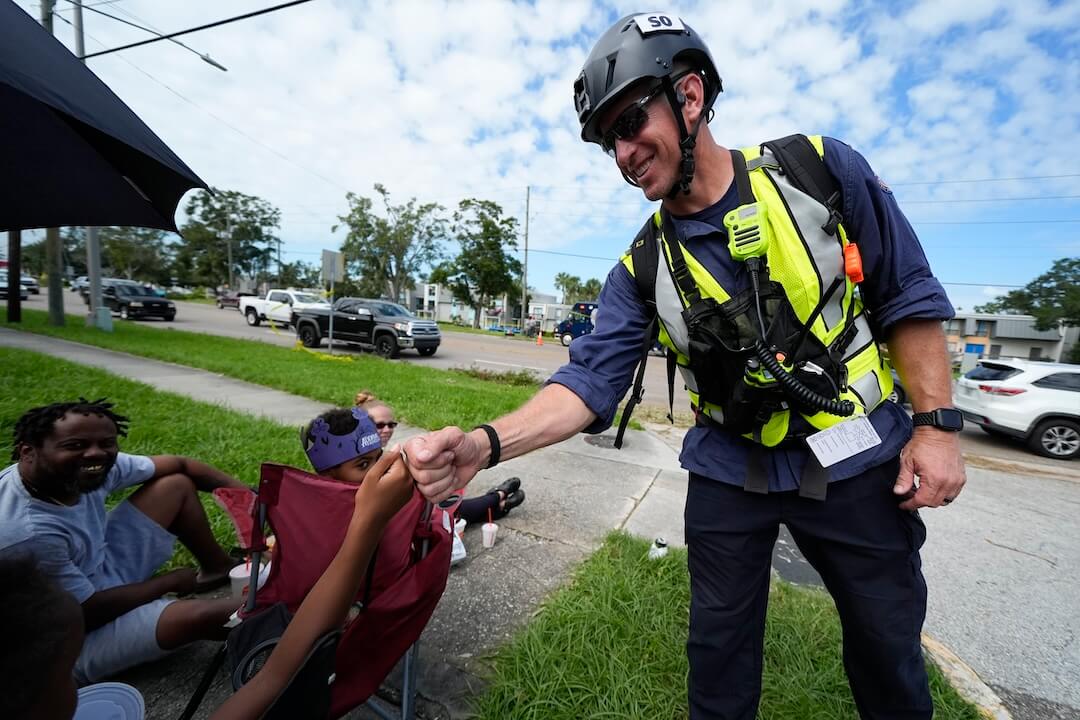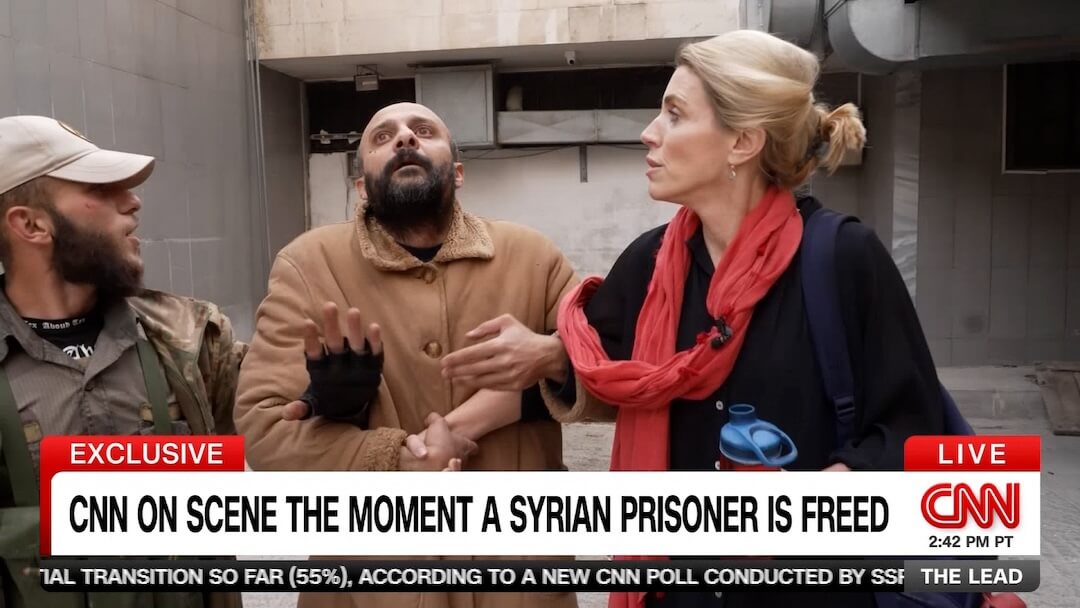The Federal Emergency Management Agency is giving victims of Hurricane Helene only $750. That $750 is only a loan. FEMA is confiscating supplies for hurricane victims. FEMA is supposed to help white people last. FEMA is supposed to help only LGBTQ+ people.
Those were among the rash of conspiracy theories that followed Hurricanes Helene and Milton, an onslaught that was “absolutely the worst that I have ever seen,” Deanne Criswell, Federal Emergency Management Agency administrator, said in early October.
That’s significant coming from the leader of a federal agency that’s been the subject of rumors and distrust for more than four decades.
Although many of the claims originate online, targeting FEMA has real-world consequences, including deterring storm victims from seeking federal aid and endangering the agency’s employees on the ground. In North Carolina, FEMA briefly paused post-Hurricane Helene relief work because of threats, and a man was arrested and charged with threatening FEMA employees. He told a local news outlet he was motivated by false social media reports that FEMA was withholding supplies.
Experts told PolitiFact that conspiracy theorists began targeting FEMA in the early 1980s, soon after its creation. The more widespread mistrust that developed over time is rooted in the agency’s supporting role in disaster relief; skepticism of government that leads some to think FEMA will attempt a government takeover; and doubts about the agency’s competency because of some of its past failures.
But the claims have increased in recent years, or at least become more visible to audiences who might not have seen them before, experts said. The COVID-19 pandemic was a pivotal event, bringing an explosion of false narratives about federal agencies, including FEMA.
Rachel Goldwasser, a Southern Poverty Law Center senior research analyst, said she’s seen an increase in, or a reemergence of, false claims about FEMA.
“There was a long time where FEMA, arguably, received some fair criticism (after Hurricane Katrina in 2005), and times where they did not receive any criticism,” Goldwasser said. “And then times such as these, where the criticism is based on conspiracy and irrationality and misinformation.”
Stacy Willett, chair of the University of Akron’s School of Disaster Science and Emergency Services, said, “There has always been a level of misinformation surrounding FEMA and disasters, but what has changed is both the increase (in) and speed of miscommunication.”
Willett said social media gives people many avenues for spreading false claims. And with the rise of artificial intelligence and foreign influence, Willett said, it’s harder to determine what’s true or false.
“Unfortunately, the United States is in for an increasingly difficult time separating fact from fiction and getting core information to survivors,” Willett said.
FEMA’s origin and mission
President Jimmy Carter signed an executive order effective April 1, 1979, that established FEMA. Another executive order in July that year gave the agency a dual mission of emergency management and civil defense. In 2002, the Homeland Security Act grouped FEMA and other agencies under the Homeland Security Department, which was created after the Sept. 11, 2001, terrorist attacks.
Over time, FEMA’s core mission has centered on disaster planning and recovery, rather than civil defense, although it does still lead the Office of National Continuity Programs, which allows federal, state and local governments to continue functioning during emergencies.
The office controls things such as the Integrated Public Alert & Warning System — which prompted much misinformation before a routine test in October 2023.
It also runs the Mount Weather Emergency Operations Center in Virginia’s Blue Ridge Mountains. That site, part of which is underground, provides support and infrastructure “to support Executive Branch continuity of operations, incident management, and classified programs for multiple federal departments and agencies,” according to a 2017 FEMA report to Congress.
A 2017 Wired story about the agency’s Cold War legacy notes, “FEMA’s under-the-radar nature was originally a feature, not a bug. During the past seven decades, the agency has evolved from a top-secret series of bunkers designed to protect US officials in case of a nuclear attack to a sprawling bureaucratic agency tasked with mobilizing help in the midst of disaster.”
When disasters strike, if a state can’t handle disaster relief on its own, federal law says its governor must formally ask FEMA for help. The president makes emergency and disaster declarations to release federal aid money.
FEMA has sought to counter false narratives about its disaster response, creating rumor control webpages for many hurricanes, including Sandy in 2012, Harvey and Irma in 2017, and Ida in 2021, and after the COVID-19 pandemic and the 2023 Maui, Hawaii, wildfires.
Early conspiracy theories: FEMA concentration camps
The Southern Poverty Law Center wrote in 2010 and again in 2015 that one of the earliest conspiratorial claims was that FEMA has the power to put U.S. citizens in concentration camps. The law center cited a 1982 newsletter from what it called an “extreme right” group warning that “hardcore patriots” would be imprisoned.
The Southern Poverty Law Center said the claims gained traction among militias and got a boost after a 1987 Miami Herald article about a plan written by former U.S. Marine Corps Lt. Col. Oliver North — a key figure in the 1980s Iran-Contra scandal — to suspend the Constitution and place the country under martial law in a national emergency.
The concentration camp conspiracy theory has been the subject of several movies, including “America Under Siege” in 1994, “Camp FEMA” in 2009 and “Police State 4: The Rise of FEMA” in 2010. Conspiracy theorist Alex Jones starred in and served as a director, respectively, for the 2009 and 2010 movies.
The FEMA camp conspiracy surfaced again in 2015 about a real multistate U.S. Army training exercise called Jade Helm 15 that began in Texas. Some bogus theories, fueled by Russians, said FEMA, with Walmart’s help, was planning the training exercise as a practice run to open internment camps. And although it’s been debunked, the idea of FEMA turning Walmart stores into concentration camps persists.
FEMA even played the villain role in the 1998 “X Files” movie, much to agency leaders’ chagrin. FEMA spokesperson Morrie Goodman told The Washington Post after the movie’s release, people have come to believe the agency has “all kinds of powers we don’t have, that we can put people in concentration camps and suspend the Constitution.”
Distrust of government agencies, amplified by the pandemic
Whitney Phillips, a University of Oregon assistant professor of digital platforms and ethics who researches conspiratorial beliefs, said there’s long been distrust of what she called “alphabet soup agencies,” such as FEMA, the Central Intelligence Agency (CIA) and the National Institutes of Health (NIH), among people on the political right, who she said see the agencies as “hopelessly compromised by liberal influence.”
“I’m sure that there are a good number of people who remember (Hurricane) Katrina and who then think, well, this is how the government operates — poorly,” Phillips said.
FEMA’s response to Hurricane Katrina was widely criticized by elected officials and the public and prompted a reevaluation of federal disaster response efforts and congressional reforms.
But claims about poor performance are different from those made by people who think FEMA is withholding aid or targeting storm victims in politically conservative areas, Phillips said.
“It’s more about the perception that the liberals that work there are radicalized against conservatives,” Phillips said.
Although false narratives about federal agencies can be traced back decades, Phillips said, there was an explosion in visibility of them — because of social media and news stories — following the COVID-19 pandemic, particularly about agencies focused on public health or collective action, such as a federal response to disasters.
Pandemic-era false claims included that FEMA planned the COVID-19 virus to kill thousands of people and open concentration camps, and that FEMA was forcing Hurricane Ida evacuees in 2021 to get COVID-19 vaccines.
The pandemic wasn’t the start of false FEMA claims, but “that’s where a lot of the stories, the narratives, really took hold and became increasingly prominent in ways that jumped from specifically right-wing networks to be things that more people outside of right-wing networks would see just by scrolling through social media,” Phillips said.
These types of false claims might have been limited to fringe groups in the past, but Phillips said they no longer are.
Becky Rouse, a former FEMA employee who teaches emergency management and homeland security courses at Tulane University, said the theories tie into a general distrust of government and the military.
“It’s not hard to understand why, between Hollywood and other countries in the world, and even our own government,” Rouse said. “Go back to internment camps for the Japanese, U.S. citizens who happen to be Asian are placed into these camps. Can some people go, ‘Hey, wait until that happens to you?’ Can they say that they can say it? Of course they can. And they might believe it.”
Rouse was referring to the U.S. government imprisoning Japanese Americans in internment camps during World War II.
Rouse, who teaches a communication course that discusses mis-, dis- and malinformation and the need for government agencies to communicate effectively, said some of the mistrust might be rooted in a lack of understanding about what the federal government can and can’t do.
“How to understand what your state’s responsible for and what the federal government can and will assist you with is pretty complicated stuff,” Rouse said.
FEMA itself has sometimes contributed to misunderstanding and confusion. In October 2007, the agency held a fake news briefing, in which agency employees pretending to be reporters asked friendly questions about FEMA’s response to California wildfires. The agency didn’t give reporters enough advance notice of the briefing, so none arrived in time, but the press conference proceeded anyway.
Hurricane claims linked to an anti-science movement
Njoki Mwarumba, a SUNY Empire State University assistant professor of emergency management, said the false claims about the hurricanes and FEMA’s response to the storms continue an antiscience trajectory that’s been building in the U.S.
“The FEMA issue is just part of the zeitgeist, so to speak,” Mwarumba said. “It’s the next thing that is very obviously being questioned,” but just a continuation, she said.
Mwarumba said FEMA has a lot of complexities, and coupled with the increase in disasters, there’s an increase in mistrust about the agency.
“People are going to actually try and allocate blame somewhere, and FEMA is in the forefront of disasters,” she said.
But that increase in mistrust doesn’t exist in a vacuum. “It exists in the larger temperature of the country,” Mwarumba said, pointing to politicians, the antiscience movement or other groups that amplify that mistrust.
FEMA through a political lens
Former President Donald Trump spread the false claim that FEMA was diverting money from hurricane relief to use for migrants, a common theme on social media in recent weeks, and he has long railed against federal agencies including the FBI and the Justice Department.
Whether politicians are influencing others to distrust federal agencies or reflecting back their supporters’ beliefs is unclear, Phillips said.
“Part of the reason that Republican politicians say these kinds of things about these agencies is that they know there’s an audience for it,” Phillips said. The audience then reinforces the claims being made and those claims gain additional audiences, she said.
Phillips said FEMA is being targeted now because it’s at the center of an important news story.
“This is prominent in people’s feeds and top of mind for people, and this happens to be the federal agency that is connected to it,” Phillips said. “So I don’t think that it’s exactly specific to FEMA.”
The November election may also be fueling the false claim. Philips described the narratives as “informational storms.”
“You can think about the election season as the ocean,” Phillips said. “The election is warming the waters and then creates more energy for the storms that already were there, but are more powerful because you’ve got this additional force that’s sort of feeding energy into all of the narratives as they emerge.”
This fact check was originally published by PolitiFact, which is part of the Poynter Institute. See the sources for this fact check here.






